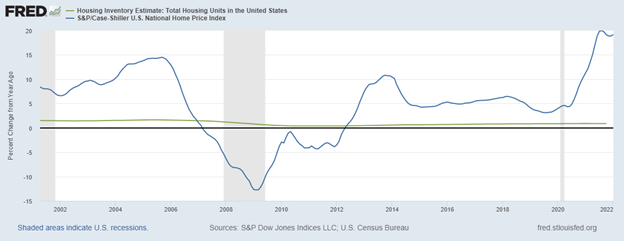The news was largely in line with expectations. Home prices rose 19.2% year over year in January, up from 18.9% in December, according to the S&P CoreLogic Case-Shiller Index.
Some analysts expect demand for homes to ease as mortgage rates rise. The average rate on the 30-year fixed-rate mortgage is now 4.4%, according to data from the Federal Reserve. That’s up from 3.1% at the end of last year.
There is some hope that declining demand will allow price pressures to ease. Higher mortgage rates have already started to affect sales in the first months of the year. Pending home sales, an indicator showing the number of signed contracts awaiting closing, was down 4.1% in February and has now fallen for four straight months according to the National Association of Realtors.
But fewer sales doesn’t mean prices will come down. The chart below shows the problem with the housing market is simply too few homes.
Housing Prices Increased With Decreased Supply

Source: Federal Reserve.
Home Prices Will Be High Until Supply Increases
The green line shows the change in the national housing supply. The number of housing units (houses, apartments and condos) has been growing by less than 1% a year since the recession in 2008. Even in the bubble years of the early 2000s, inventory increased by less than 1.5% per year.
Housing supply hasn’t kept up with population growth. That means there is more demand than supply, which may be the primary reason home prices are rising so much.
The sudden increase in price seems to have been spurred by the pandemic. Many households decided to move during the height of COVID-19.
If they sold homes in high-priced cities and are now looking to buy in low-priced markets, they are driving up prices there. People left in the cities seem to be spreading out, abandoning roommates in favor of one-bedroom apartments.
Bottom line: Until supply increases, we should expect homes to remain expensive.
Click here to join True Options Masters.



